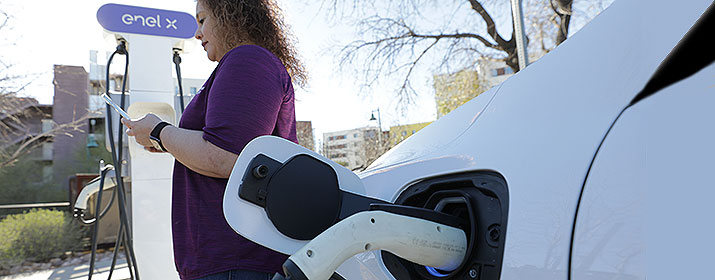
As electric vehicles (EVs) become increasingly commonplace, businesses are recognizing the need to install EV charging infrastructure. Whether you’re looking to attract eco-conscious customers, provide a valuable amenity for employees, or help address pressing environmental issues, installing EV chargers can be a smart business move.
TEP offers rebates to qualifying businesses to offset the cost of the installation.
You may have questions about how to get started. Consider these key steps and considerations.
1. Deciding which charger best fits your needs
Before diving into the installation process, it’s important to understand the types of chargers available:
- Level 2 (L2) chargers: These provide 7-19 kW of power, adding about 10-25+ miles of range per hour of charging. They’re suitable for locations where vehicles might be parked for several hours.
- DC Fast Chargers (DCFC): Offering 50-350 kW of power, these can add 180-240+ miles of range per hour, with full charges possible in 20-60 minutes. They’re ideal for locations with high turnover.
Beyond charging speed needs, you may also want to consider:
- Compatibility with your electrical infrastructure
- Network connectivity features
- Durability and weather resistance
2. Selecting the right installer
Choosing a qualified installer is crucial for a successful project. TEP helps at every stage of the project and maintains a list of qualified contractors. For more information, go to: https://tepev.clearesult.com/home
To help select a qualified contractor, be sure to ask the following questions:
- Are they licensed, bonded, and insured in Arizona? Look for a C-11 or CR-11 license on the Arizona Registrar of Contractors website.
- Do they have experience with EV charger installations and commissioning?
- Can they provide references from similar projects?
- Are they familiar with local electric utility requirements (e.g., TEP’s Electric Service Requirements)?
- Will they conduct a site visit to assess your specific needs?
- Can they provide a detailed proposal and estimate?
It’s advisable to get at least three estimates to compare services and costs. Refer to TEP’s Smart EV Charging Program for additional details and to see if your business qualifies for a rebate.
3. Initiating project design and planning
Once you’ve selected an installer, they should help you determine the best configuration for your site. This may involve:
- Connecting chargers to an existing electric panel
- Upgrading an existing panel
- Installing a dedicated new electric service
Your installer should also help you navigate any necessary permit applications and coordinate with your local utility if service upgrades are required. TEP offers support to businesses who are considering EV charger installation.
4. Key questions for charger vendors
When evaluating charger options, ask vendors the following:
- What are the costs for hardware versus ongoing network connectivity?
- What payment or operational models are available (e.g., leasing, charging-as-a-service, full ownership)?
- What payment options can be set up for users? Are there processing fees?
- What warranty and maintenance services are offered?
- How are hardware issues and software/network issues handled? What are typical response times?
- Are replacement parts readily available?
5. Finalizing installation and commissioning
Your chosen installer will handle the physical installation of the chargers and any necessary electrical work. They should also ensure that the chargers are properly commissioned and connected to any required networks.
6. Wrapping up a few post-installation considerations
After installation:
- Familiarize yourself with warranty and service agreements
- Set up payment systems and user access
- Create policies for charger use (This is especially important for workplace charging.)
- Understand any ongoing maintenance requirements
Remember, if you’re participating in a rebate program, there may be requirements to keep the chargers operational for a certain period (e.g., 5 years for TEP’s program). Check with TEP for details.
With careful planning and the right partners, installing EV chargers at your business can be a smooth and rewarding experience. By understanding the key steps and asking the right questions, you can ensure that your EV charging installation meets your business needs and provides value to your customers and employees for years to come.






